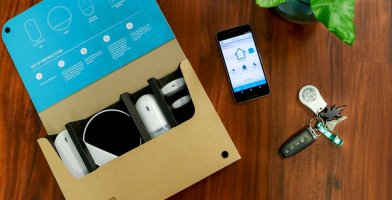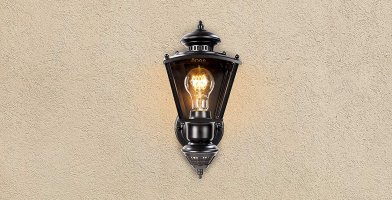Best LED Light Bulbs Reviewed and Tested
You may be torn between keeping the traditional incandescent light bulb you’re already familiar with or sticking your neck out and buying the most current LED light bulbs. Or just looking to upgrade your aging LED bulbs. LED light bulbs have multiple advantages and benefits over their incandescent counterparts and owing to technological advancements they can reduce your electrical consumption by an astounding 80 percent. A majority of them consume between 8 and 11 watts of power an hour, compared to the 60-Watts of incandescent bulbs! Most LEDs are similarly compatible with dimmer switches, allowing you to comfortably tune the color temperature to a level of your preference. And they differ vastly in features, with some having Wi-Fi capabilities, others being more energy efficient, while others are dimmable. In deciding on the most suitable one to buy, you’ll have to consider a few important factors, if you haven’t already. Key factors among these are energy efficiency, level of customization, smart features and most importantly – your needs. Considerable effort should go into ensuring you get a LED light bulb that emits the right color, the right amount of light and evenly distributes light throughout the room.
Our Top 3 Picks
[srpshortcode id=”6306″][/srpshortcode][srpshortcode id=”6305″][/srpshortcode][srpshortcode id=”6307″][/srpshortcode]
Criteria for Choosing the Best LED Light Bulbs
Energy Consumption
Most incandescent bulbs with a power rating of 60-Watts output approximately 800 lumens of light, which by all means is adequate for everyday lighting. However, there is a serious mismatch between their rate of energy consumption and light output as rake up significant electrical bills while producing the same level of brightness as most LED light bulbs. It, therefore goes without saying that it’s prudent to get an LED light bulb with more lumens and operating at a lower voltage.
While on the topic of energy consumption, you’ll also need to ensure your LED light bulb is professionally constructed to last for several years. A typical LED light bulb operating for approximately three hours on a daily basis should last for a maximum of 25,000 hours, which translates to 23 years or so. A quick check on the Lighting Facts label on the bulb should give you all the information you need concerning its longevity and the approximate cost of running it for a year.
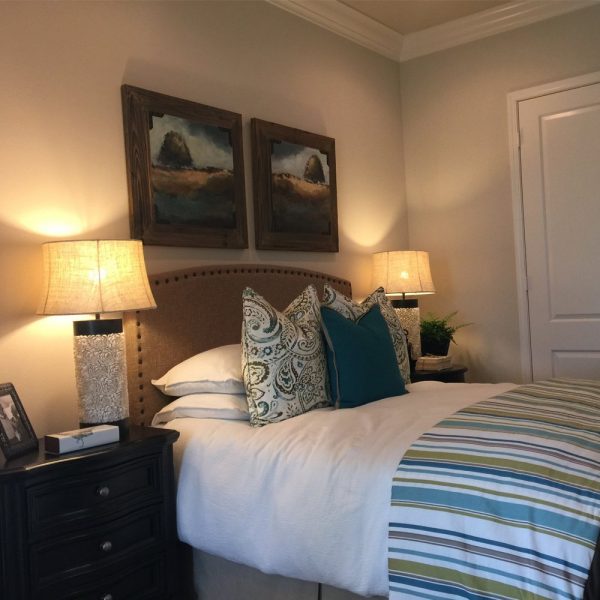
Bulb Features
While LED light bulbs have nearly similar characteristics, they are not precisely as identical as those of traditional incandescent bulbs. The length and diameter of LED light bulbs and incandescent bulbs are also nearly alike, varying only slightly from one brand to another. Those with additional features such as Wi-Fi are also likely to be heavier and a little bulkier than their incandescent counterparts, meaning that they may fit relatively easily into standard lighting fixtures.
Weaker light fixtures may also not support the extra weight, forcing to tighten or replace them before buying. Plus, since you’ll be dealing with LED light bulbs, which, despite their advanced designs still generate considerable amounts of heat, you may not want to use the LEDs in enclosed spaces as doing so would considerable shorten their shelf life.
Some LED light bulbs are also not designed to be used in outdoor environments as they cannot withstand dampness and harsh environmental conditions. Same goes for dimming: you need to verify whether your choice is dimmable and to which extent before buying. Lastly, some LEDs are better than others for evenly distributing light throughout a particular room, which needs to be a key consideration if your room is unusually large.
Colour Spectrum
Color spectrum is equally a vital consideration when it comes to getting an LED light bulb that best meets your needs. The position of your light bulb on the color spectrum will determine the kind and type of color it emits, and whether it will be a yellow or white glow. LEDs are capable of emitting several shades of a color, ranging from a warm to a cool white. It’s worth noting that bulbs with a lower color temperature are notorious for emitting a yellow shade together with the white light.
10 Best LED Light Bulbs
2. Philips
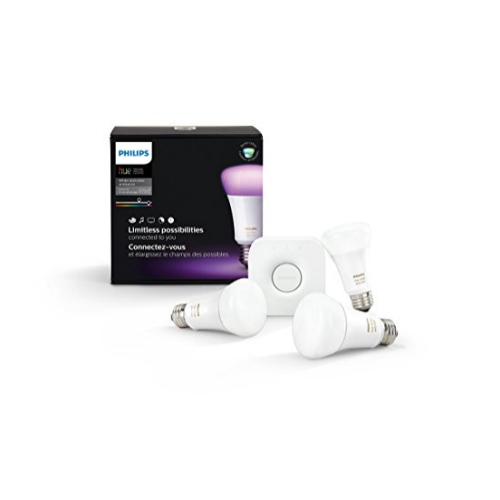
There is a user-friendly mobile device app for the easy and hassle-free controlling of the four bulbs. The app allows you to keep track of all the bulbs, closely monitoring whether the Philips' lights are switched on or off in all the rooms in which they are installed. Supposing all the bulbs are within the same room, you have the freedom of turning all of them either on or off and even control them individually, choosing the ones you want to remain on while keeping the others switched off. There's a Routine Mode for scheduling when lights turn on or off is specific rooms of the house. The Only after Sunset Mode, as the name suggests, allows you to schedule lights to turn only after the sun sets while the Vacation Mode comes handy when you're not home but have to give the impression that you are by randomly turning the lights on and off throughout the night. To top it all off, the Philips Hue Smart Lighting Bulbs has a geofencing feature which, when paired with an IFTTT applet, will switch the lights either on or off when you're leaving or coming home, depending on your preference. And, with their 25000 hours of use, you won't be looking for replacements anytime soon.
To summarize, ever since its introduction into the market as the first Wi-Fi-enable LED light bulb, the popularity of Philips Hue Smart Lighting Bulbs has never dwindled and coupled with its commercial-grade and quality construction it continues to outperform and outsell its closest rivals. Inside the starter kit are three regular screw-fit lightbulbs whose status you easily adjust with the use of a smart device through a hub connected to a router. The design of the Philips Hue Smart Lighting Bulbs allows you to make adjustments to such aspects as the bulbs brightness conveniently, colour and timing from the comfort of your couch or when working miles away from home. And if you have an expansive home, you'll be pleased to note the mobile phone app allows to control up to 50 bulbs in different rooms with just a single device, making it possible for you to choose the most suitable or desired colour. With a little creativity and curiosity, you'll be able to explore the several possibilities the Philips Hue Smart Lighting Bulbs offers.
Emits a sharp, warm glow for exceptional lighting
Capable of changing colours along the RGB spectrum
Compatible with IFTT
Difficulty saving colours and temperatures
1. LIFX
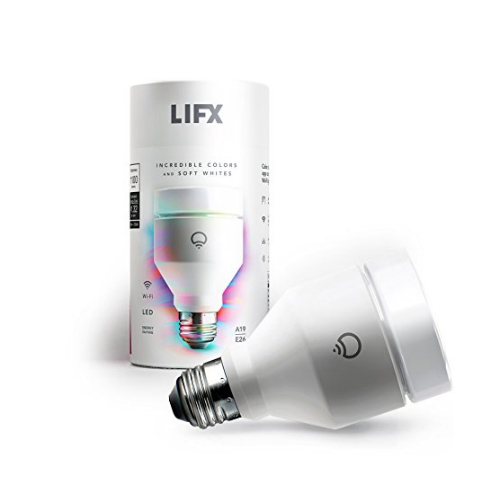
It provides you with a stable and reliable performance after a successful installation, devoid of the connection and synchronization issues plaguing its other competitors, and making it possible for you to control the bulb’s status irrespective of whether you’re home or not. The LED light comes with three tabs for controlling various aspects of its smart features, with the first, the colours tab, allowing you to choose a colour of your choice and its corresponding dimmer effects. Choosing dark blue, for instance, would require turning the dimmer down to between 30 and 50 percent after selecting the blue hue.
The second tab is for setting different shades of the colour white using a layout similar to the first tab's with Kelvin values ranging from a low of 2500K to a high of 9000K. The last is the effects tab that allow you to access the "smart" features, with the coolest and most practical being the music visualizer that matches the bulb's emission of LED's light intensity in accordance to the beat of the music. The other effects are a self-explanatory candle flicker mode, colour cycle effect, and the strobe mode. The last modes enable the quick flashing of the LIFX to produce a strobe-light effect, even though the design does not allow for the toggling of the effect, thus requiring that you continuously hold onto the switch.
Regarding performance, it will never disappoint. You have the freedom of customizing the temperature of the bulb's white hue to match your mood and the demands of your job. You can conveniently dim the lights by simply tapping on an easy-to-use app on your mobile device. Furthermore, with an energy rating of just 17W, the LIFX LED Light Bulb effortlessly emits an impressive 1000 lumens which brings its performance on par with a conventional 75W bulb. You need to note however that even when the LED bulb is in a standby mode, it utilizes 1.7 Watts to ensure the efficient running of its Wi-Fi functionalities.
Lastly, the professional construction and finishing of the LIFX LED Light Bulb guarantees long-lasting performance. With a rating of 40,000 hours of use, the chances of experiencing any performance issues like freezes and crashes are almost non-exist. Remotely managing lights and integrating them with other "smart" household feels almost like a breeze. With these and additional features, we can't possibly cover in this article, rest assured you can never go wrong with the LIFX LED Light Bulb.
Several bulbs for increased versatility
Produces one of the cleanest, brightest, and whitest lights without dim spots
Easy to set up and use
Works without a bridge
Comes with a huge collection of colours
Low power consumption
Requires the use of a bridge for optimal operation
Comes with a steep price tag
Does not support IFTTT
3. Cree
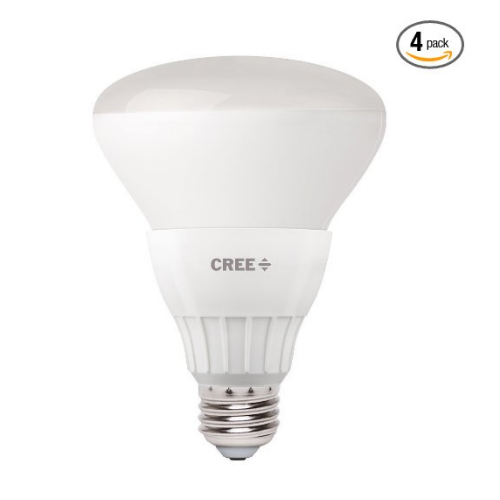
The Cree bulb is both lightweight and compact and will fit with ease and firmly in most lighting fixtures, especially with its rounded top and smooth sides. With a length of 4.4-inches and a diameter measuring 2.4-inches, screwing them into regular A19-lamp outlets takes a matter of seconds and simple enough to be done by nearly any person in the house. And because it is light, you don't have to worry about fixing it on any weak sockets around the house. C
ompared to CFL bulbs that take a few seconds or even minutes before lighting up as they have to warm up first, the Cree one lights up immediately, reaching their optimal Kelvin level for efficient performance. Given that they are omnidirectional, they evenly distribute light to the entire room including the most confined, giving the impression that the lights are less artificial and more natural.
It is offered in white and daylight colour variations with the latter being better at emulating the naturalness of sunlight, providing you with a brighter, whiter light. Owing to its lighting characteristics, daylight bulbs are best to use in areas that require more illumination, for instance, the kitchen or the study room. Soft while bulbs, on the other hand, are more optimized for lighting up bedrooms and other rooms that don't require intense light.
This is one of the most versatile and flexible lights you can find out there. They are designed for both indoor and outdoor use, and are additionally compatible with dimmer switches, providing you with instant, steady light throughout the lighting duration. The bulbs work quietly without sputtering. And because of the independent operation of LED diodes, should one of the bulbs malfunction the remaining bulbs will continue providing you with the light you require to continue with the activity you were undertaking. One of the most significant advantages of the Cree 9.5-Watt LED Light Bulb is the fact that instead of extinguishing all at once, as is the case with CFL and traditional incandescent bulbs, they gradually lose their brightness as they approach the end of their useful life, giving you adequate time to look for replacements.
Pocket-friendly
Energy-efficient
Long lifespan
Easy to use
Emits bright and sharp light
A little bulky
4. BeOn Home

It has the capability of learning your activity patterns over a certain period at the end of which they will be sequentially turning themselves or off depending on your location within the house. In case you are at work, or thousands of miles away on a business trip and the doorbell goes off, the bulbs immediately start replaying the pattern, giving the intruder, would-be burglar or visitor the feeling that you are home. The only drawback of the arrangement is that a knock on the door will not yield results similar to ringing the doorbell, which might make it difficult to fool people that you're home when you aren't.
For optimal performance, and because the entire system relies on the smart Bluetooth mesh technology, it is recommended that the bulbs are spaced utmost 160 feet from one another. Depending on the electrical configuration of your home, you may want to install additional lighting fixtures to achieve a solid and reliable connection. Also, keep in mind that even though the bulbs are somewhat lightweight, they’re nonetheless a little bulkier than their traditional incandescent counterparts and therefore won’t fit perfectly into tight spaces.
The installation procedure is quite simple and very straightforward and should not take you more than a couple of minutes. The brand's highly customizable app can be installed on any smart mobile device after which it walks you through the remaining installation steps, beginning with the automatic discovery of all the installed bulbs in the house. Since you'll be required to give the bulbs monikers for better and more efficient control, it would be more prudent to install one bulb at a time, giving them names as you go rather than installing all of them first and naming them later. After successful installation, the whole system works like a charm, allowing you to painlessly and comfortably control the brightness of the bulbs either collectively or individually, as long as you’re not more than 30 feet from the house. Assuming you’ll be using them for some three hours every day, the BeOn Home Smart LED Bulbs bulbs have a lifespan of 25,000 hours or 22 years
The two most essential modes for controlling the bulbs are the Welcome and Away Modes. The former will keep the lights on for some three minutes irrespective of the position of the switch button. The Away mode, on the other hand, randomly turns the lights on and off in accordance with a pre-set pattern, thereby giving the impression that you're home. Since the bulbs have no Wi-Fi capabilities and cannot be controlled outside of the 30-feet range, you can only set the Away Mode while still in the house. The BeOn have two significant drawbacks, however, and these are the inability to the bulbs through the Internet and lack of seamless integration with other home-control systems.
Easy-to-use app
Quick setup
Uses power efficiently
Provides you with an ability to schedule the lighting of bulbs
Cannot be controlled remotely
5. TP-Link Wi-Fi

The Tuneable White Light LB120 is similar to the first bulb in brightness and consumes a similar amount of power. The bulb allows you the freedom of varying the bulbs colour temperature within a range of between 2700K and 6500K. The ability to tune the colour temperature up or down allows you to choose a level that is ideal for performing certain activities at different times of the day. An energizing light throughout the course of the day significantly enhances your efficiency and productivity while at work while a tuned down and more relaxing warm light is more suited for the bedroom as you prepare to retire to sleep.
The last bulb, the Colour-Changeable Light LB130, is just as bright as the other two at 800 lumens and consumes slightly more power of 11 Watts. The mode allows you to tune the colour temperate from a minimum of 2500K to a maximum of 6500K and being an RGB bulb, you have the freedom of picking literally any colour falling within the RGB colour spectrum.
The brand understands the importance of simplifying the installation procedure to make it possible for veteran electricians, Do-It-Yourselfers, and even the most clueless novices to use the lights easily. Installing it takes a matter of seconds and only requires that you swap out the conventional ones before you screw in the TP-Link Smart Wi-Fi LED Bulb. However, in case you were wondering, the bulbs are not compatible with dimmers as they require full power for optimal operation and lighting of every part of the room.
Because of the direction connection between the TP-Link Smart Wi-Fi LED Bulb and your Wi-Fi without going through a bridge, it is relatively cheaper buying and installing a single bulb, unlike the case with other systems. The brand's Kasa app allows for the seamless connection between your smart device, the TP-Link Smart Wi-Fi LED Bulb’s Wi-Fi network, and finally the home network. The app promptly discovers all the configured bulbs upon connection and has an easy-to-use homepage for the easy toggling of different bulbs in different rooms on and off.
You can reset the default preference allowing you take the bulbs from a dim and atmospheric level to a level of brightness that evenly illuminates all corners of a room. One of the main and unique highlights is the Circadian Rhythm mode which works by automatically adjusting the brightness and colour temperature of the bulb by the time of day. Consequently, the lights will be brighter and colder in the morning before shifting to dimmer at midday and finally full warm-light bright as evening approaches. However, the manufacturer does not provide any remotes for controlling the bulbs leaving you with just the phone as your primary means of setting different scenes.
Easy installation and use
Does not require a hub to function
Easy Wi-Fi setup
Comes with professionally constructed bulbs
Equipped with Circadian automatic colour-tuning
No IFTT compatibility
Unreliable Wi-Fi connection
6. Philips SlimStyle
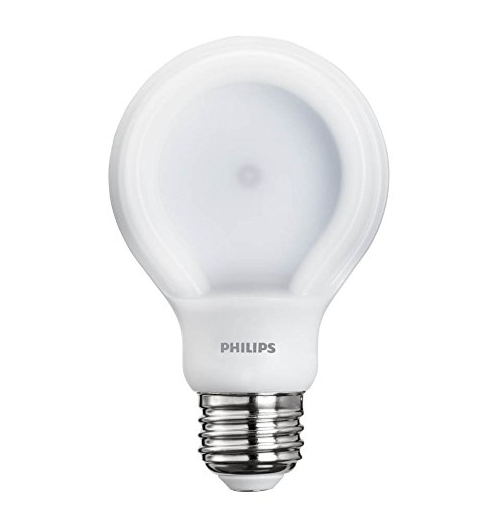
The Philips SlimStyle LED light bulbs are one of the most energy-efficient yet bright bulbs you will come across in today's market. The flat design of the bulbs in no way compromises their capacity to light up a room like any other standard light bulb. They have a brightness level of 800 lumens making them capable of casting a warm yellow light on different surfaces while running on only 10.5 Watts of power. Their colour temperature accuracy also stands at just below 2700K, confirming the Philips SlimStyle LED as a perfect replacement for a 60-Watt traditional incandescent bulb.
While the flat design goes a long way in making it an efficient producer of light and energy saver, it does present a small problem when it comes to the brand's claim that the bulbs are omnidirectional – a bulb's ability to evenly distribute light in all directions. The problem is more pronounced on the right and left sides of the Philips SlimStyle LED's profile and when the bulbs are used under a lampshade. While the flaw is not a deal breaker, according to us, that is, it is entirely up to you to decide whether the dim spots would be a bother. If on the other hand, your heart is dead set on getting a truly omnidirectional light, you may consider spending a patting with a little more dollar for a top-model LED light bulb.
Another factor likely to influence your buying decision is the fact that the bulbs have 36-month limited warranty which, while it's substantially shorter than the 10-year long warranty offered by other brands, is enough to give you a peace of mind. They come with dimmer capabilities, and while their performance is not at par with other top-level LED light bulbs, it is sufficient to create a desirable mood. The bulbs are victims to the prevalent problem of flickering among dimmable lights and produces a noticeable buzz when used with different switches. Consequently, if you insist on buying light bulbs to provide you with a smooth, dimmable lights devoid of flickering and buzzing, a perfect alternative would be the brand's standard 60-Watt Equivalent LED.
Impressively long 22.8 years lifespan
Energy efficient
Produces warm, beautiful light
Compatible with nearly all dimmer switches
Relatively short 36-month warranty
Expensive
7. Feit
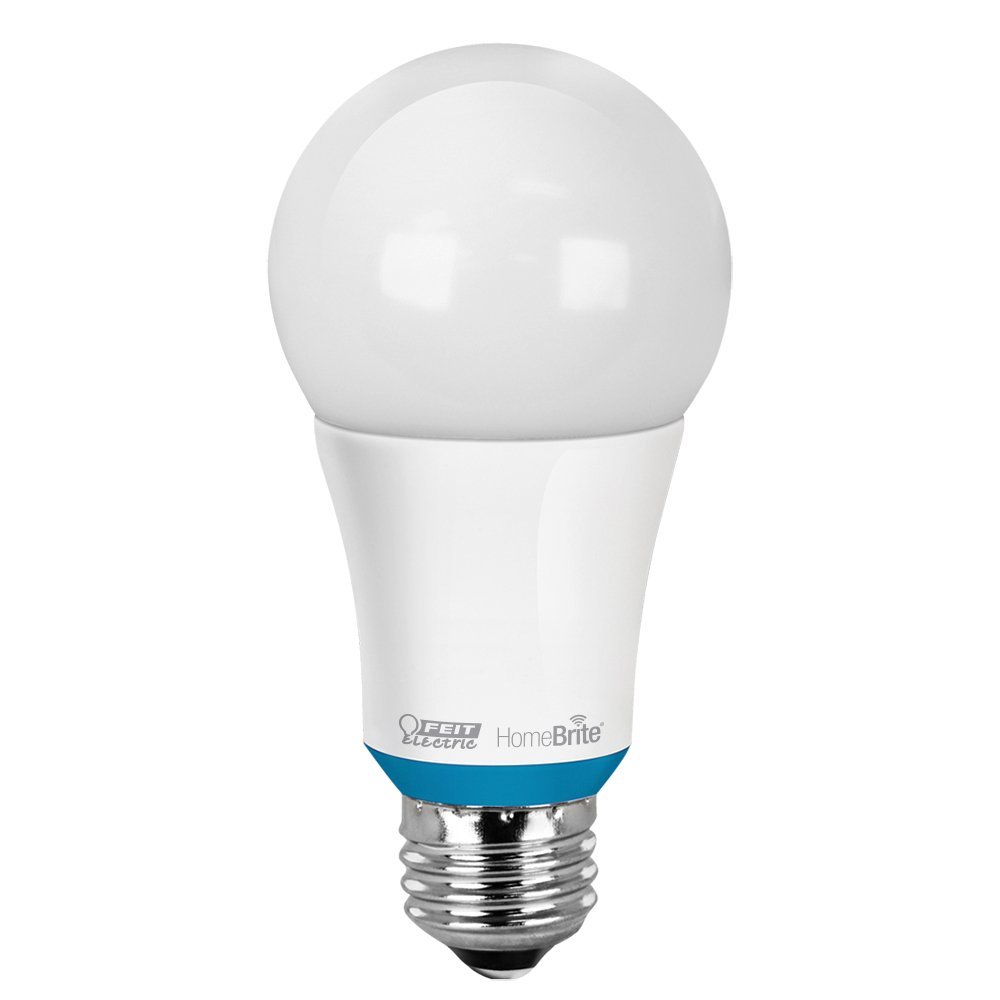
The performance of Feit in terms of brightness, colour temperature and the effect of heat build-up on the bulbs’ performance wasn’t however comparable to most LED light bulbs in its class. All of its four bulbs, the A-shaped bulb, the B10-shaped candelabra bulb, the BR30-shaped floodlight, and the weather-proof PAR38-shaped outdoor floodlight, were considerably dimmer with the first and second having a brightness level of just 672 and 277 lumens, respectively, all falling below their expected brightness levels. The Better heat management and quality construction of the system bulbs nonetheless ensured the brightness level never dipped below average even after 60 minutes of continuous use.
To simplify the process of controlling it through your smart device, the brand provides you with a clean and easy-to-use HomeBrite app. After a successful installation and registration, the app automatically scans and maps out all the pre-configured bulbs if they're within range. From here, turning the light bulbs on or off should be a breeze. You can additionally dim them up or down, schedule when they go on and off, control all of them together or individually from just a single device.
Unlike the previously reviewed LED light bulbs, the Feit conspicuously lacks a full RGB colour control, neither is there an option for tuning the colour temperatures to match different times of the day. Additionally, since they lack third-party compatibility, the Feit Electric HomeBrite Bluetooth Smart LED System cannot work with HomeKit, Alexa, Nest, SmartThings, or IFTTT. The implication, in very simple words, is that you forget about turning the light bulbs on or off with voice commands, triggering them through motion detectors, or syncing them up with a smart hub, which would have otherwise allowed you to extend usage beyond the limiting Bluetooth range.
In all, the Feit Electric HomeBrite Bluetooth Smart LED System is a perfect choice for people looking for decent and functional LED light bulbs to light up both indoor and outdoor environments. The bulbs are weatherproof and compatible with dimmers meaning that you'll be able to select the desired level of brightness corresponding the activity you're undertaking. These bulbs are very energy efficient, drawing just 18-Watts of power and with their sturdy construction, can last at least 22 years if used properly.
Offers you an ability to control schedules
Easy Bluetooth setup
Pocket-friendly price tag
Long-lasting at 25,000 hours or 22 years
Comprehensive collection of bulbs for different circumstances
Lacks third-party compatibility
Bluetooth doesn’t function when you’re out of range
8. Philips 60-Watt
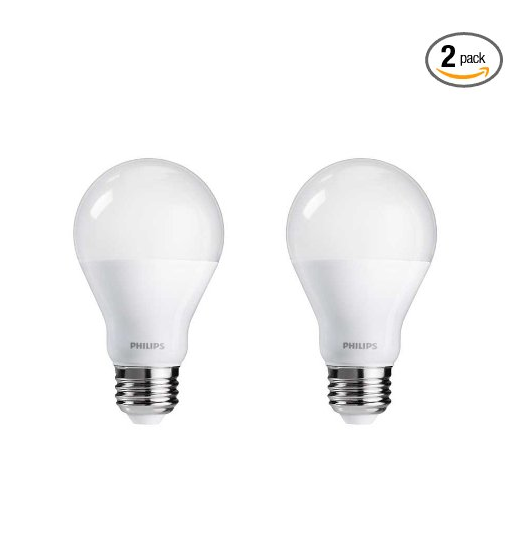
Other than the lack of a dimmable design, these have specs and features that are more suited for an LED aiming at replacing the conventional 60-Watt incandescent bulb. The bulbs are capable of outputting 800 lumens of bright light at a correspondingly warm and familiar colour temperature of 2,700K, drawing just 8.5-Watts of power while at it. There is a daylight version of the Philips 60-Watt Replacement LED capable of shining at 5000K. The first colour temperature is a lot warmer and gives a cozier vibe helping you to relax after a hard day at work. The daylight version with its 5000 K of colour temperature is an attempt imitating the natural sunlight and aims at keeping you awake and energized and more ideal for the workplace. Working with the assumption that you’ll be running a single bulb for three hours every day, the bulb will account for a paltry $1 on your annual electrical bill. To help you get a better perspective on the energy efficiency of the Philips 60-Watt Replacement LED light bulbs, consider that a standard 60-Watt replacement fluorescent bulb will dent your electrical bill by about $2 while a 60-Watt incandescent bulb will have you part with $7!
An aspect that we particularly like is their near-spherical design, helping in the even distribution of light on different surfaces and areas around the house. Because of their omnidirectional properties, these LED lights are ideal for use with bedside reading lamps whose performance depend, to a large extent, on downward-angled light.
In all, the Philips 60-Watt Replacement LED light bulbs offers you a sweet spot between efficiency and exceptional performance and has all the other key features that make them an ideal replacement for a traditional incandescent bulb. Its cost-friendly price tag entirely compensates for the bulbs' non-compatibility with dimmer switches and its considerably shorter lifespan.
Lasts for up to 22.8 years or 20,000 lighting hours
Energy efficient thus saving on lighting expenses
Stylish bulbs
Emits nice, bright, and warm light
Omnidirectional properties allowing for the even distribution of light
Pricey
Poor, flickering dimmer performance
9. Osram 60W
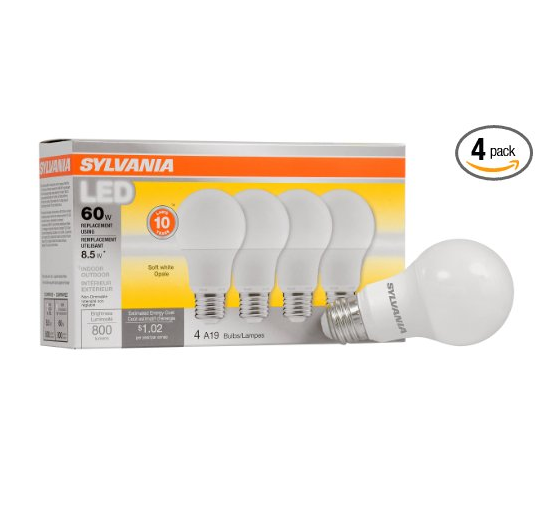
To begin with, it brightly lights up any room despite drawing just 8.5-Watts of power, which is one of the lowest power draws among most LED light bulbs on the market. It is, therefore, a better bet if you're looking to reduce your power consumption, offering you an incredible 94 lumens for every watt of power at a colour temperature of 2700K. You shall have made some significant savings in case you're going to be using it all through its 25,000-hour shelf-life. Using the bulb for just three hours adds a paltry $1 to your yearly utility bill, which would not account for anything it wasn't for the sturdy and durable construction of the bulbs. And with an impressively long 60-month warranty, you'll be using the Osram 60W with a peace of mind, never worrying about it malfunctioning.
And if that's not enough to influence you buying decision, know that the LED light bulbs are designed to stand dampness, meaning that you can comfortably install them both in outdoor and indoor lighting fixtures without worrying about the rain or snow affecting their performance. Plus, they come with impressive omnidirectional capabilities, evenly distributing heat throughout the room without not so much as a flicker or buzz. And because they work seamlessly with dimmer switch, you have the freedom of dialing down the colour temperature of the high 100 percent brightness to a low of 0 percent! No other LED light bulb offers similar capabilities. They should however never be used in enclosed fixtures as the heat generated while running can adversely affect its longevity.
Reasonably priced
Energy-efficient drawing just 8.5-Watts
Compatible with different dimmer switches
Emits bright and sharp light for efficient lighting
Dimmable to an impressive 10 percent colour temperature
Lacks Wi-Fi capabilities
10. GE Reveal A19

It is also compatible with nearly all types of dimmer switches, making it possible for you to create a mood or atmosphere that best matches the type of activity you want to undertake. If you wanted to feel invigorated and energized while at work, for instance, all you have to do is tune up the colour temperature. Creating a relaxed mood, on the other hand, will necessitate tuning down the colour temperature to a more suitable level, and the bulb allows tuning down from a high of 2500K to as much as 20 percent of that seamlessly and almost in an instant. While doing so, it will not produce the yellow glow common with most incandescent bulbs. In the latter case, the LED light bulbs will enhance the look of your room, making it more vivid yet lively.
The GE Reveal A19 LED Dimmable Light Bulb also accurately represents GE’s commitment to quality and durability, having been constructed from industrial-grade materials and components. Different from the traditional or conventional incandescent bulbs of yesteryears, these bulbs don’t have even the slightest trace of mercury.
Additionally, assuming you’ll be using these LED light bulbs for an average of 3 hours every day, expect them to last for at least 13 years, a fact that will save you considerable financial resources over those years.
High efficacy
Long life
Exceptionally bright
Quality construction
Expensive
FAQs
Q: Are LED light bulbs very bright?
A: The brightness of typical LED light bulbs ranges from a low of 50 lumens to a high of 1200 lumens, with the brightest reserved for spotlights and floodlights. These bulbs, running on 25-Watts of power, have more brightness comparable to those of conventional incandescent bulbs running at 120-Watts. The brightness LEDs produce an average of 600 lumens, which is bright enough to light up an average-sized room.
Q: What is the difference in efficiency between an incandescent light bulb and a LED light bulb?
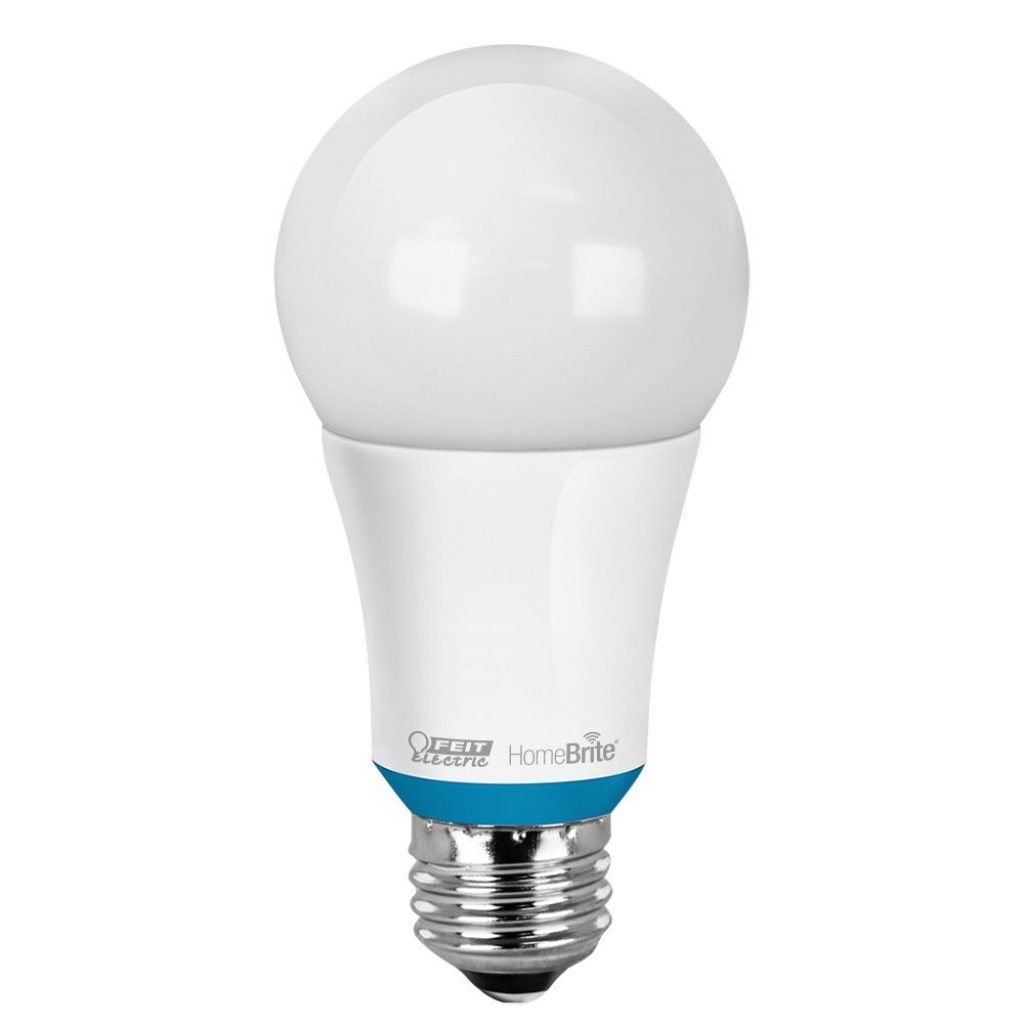
A: The newer generation of LED light bulbs are nearly five times better than their incandescent counterparts regarding efficiency. They use about 20 percent of the energy incandescent bulbs use even though their levels of brightness are similar, which translates to significant savings over time.
Q: What is meaning of “cool white” and “warm white” as used in the description of LED light bulbs?
A: In the case of LED light bulbs, warm white has a color temperature range of between 2700 K, commonly known as warm yellow-white, and 7000 K, which is cool blue-white. To put this in perspective, a typical incandescent bulb comes with a color temperature of about 2800 K while that of a halogen bulb stands at 4500 K and that of a cool white fluorescent falls at 6000 K.
Conclusion
LED light bulbs are increasingly gaining popularity among homeowners due to their energy-efficiency and omnidirectional capabilities. The smart ones, like the LIFX LED light bulb for example, are Wi-Fi-enabled meaning that you have the freedom of controlling them even when you’re halfway around the world. A few are quite versatile, and can be used in both indoor and outdoor environments without worrying about adverse weather conditions affecting their performance. And to further encourage you to get one of your choices, the LEDs feature solid construction and have an average of 22,000 hours of useful life.



